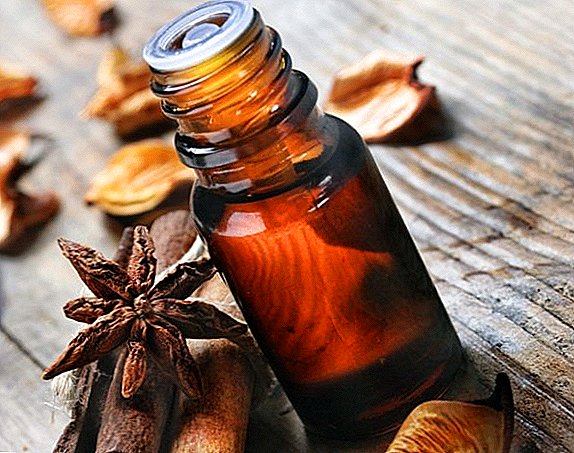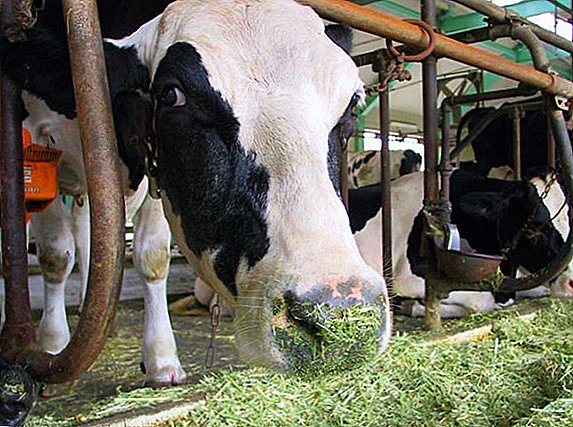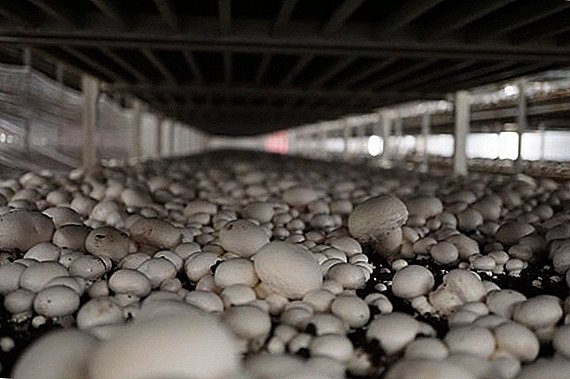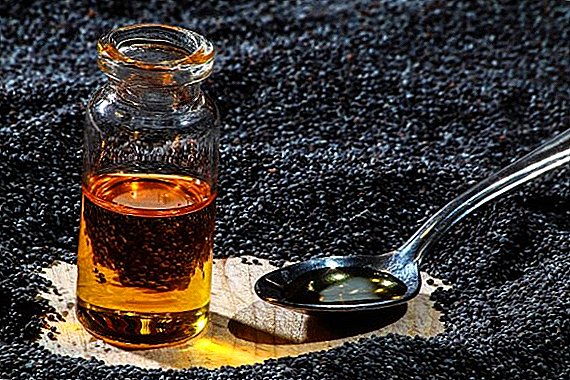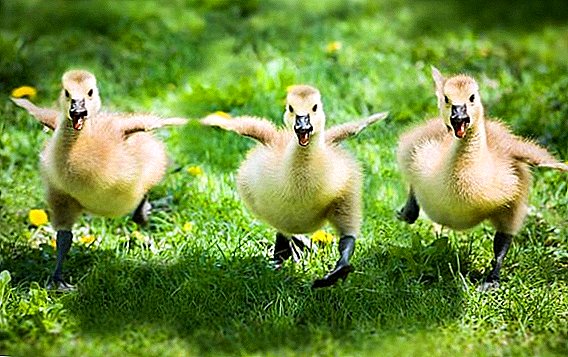 Geese traditionally belong to the category of poultry, which has good health and resistance to various infections and diseases. But such characteristics are inherent in adults, whereas chicks up to six months are subject to health problems due to unformed immunity. It is useful for both a large breeder and an ordinary farmer to know what young people are threatened at that age most often, how to deal with danger and what effective methods of prevention exist.
Geese traditionally belong to the category of poultry, which has good health and resistance to various infections and diseases. But such characteristics are inherent in adults, whereas chicks up to six months are subject to health problems due to unformed immunity. It is useful for both a large breeder and an ordinary farmer to know what young people are threatened at that age most often, how to deal with danger and what effective methods of prevention exist.
Aspergillosis
This infectious disease occurs after infection with the fungus Aspergillus and affects the respiratory system.
The pathogen grows in wet food, straw, grain, on dampened walls of rooms. It spreads with the help of spores, which, when ingested by birds, cause the disease. But for the further development of the dispute are necessary conditions that weaken the immune system:
- poor ventilation in the room;
- dampness;
- rare walks in the fresh air;
- unbalanced nutrition.
Important! If a sick bird is found in the flock, it is necessary to separate it from the main mass. Also, do not forget to get rid of bedding, food, equipment in the house - through them fungus can also be transmitted.
The incubation period takes an average of 3 to 10 days.

Symptoms
When an aggravation occurs, it is easy to recognize it by the following features:
- passivity of the chick;
- ruffled feathers;
- lack of appetite;
- shortness of breath;
- sputum from the nose.
The acute form lasts 1-3 days, after which the bird dies. On average, the case of aspergillosis is 80%.
Learn how to build a goose and equip it with feeders, drinking bowls.
Prevention
Such a serious disease is easier to prevent than to cure.
For the prevention of aspergillosis using drugs based on iodine:
- potassium iodide (sodium), diluted in water or added to feed;
- iodized milk.

To prevent aspergillosis, it is important to control the preparation of goose feeds:
- collect greens and hay only in dry weather;
- Store them in a closed, well-ventilated area.
Treatment
When aspergillosis occurs in a herd, the only way to combat the disease is to destroy the infected individuals. There is an opinion that it is possible to cure a bird by otpaivaniya aqueous solution: 370 e. D. nystatin per 1 liter of water, give every day for 6 minutes. But there is no scientific confirmation of this theory.
Did you know? The average life expectancy of domestic geese is 25 years.
After the removal of diseased birds, it is important to urgently decontaminate the house:
- The first step is to destroy the litter and litter.
- At 1 cu. m room should take 10 ml of a 0.5% solution of iodized aerosol.
- Apply for 40 minutes, spraying over the house.
- Birds should not be taken out of the room during processing: fungus spores can also remain on their feathers.
- Disinfection is carried out daily for 6 days.

Cloacite
The inflammation of the mucous membrane of the cloaca is called cloacitis.
Symptoms
The causes of this disease include the lack of minerals and the classic vitamin kit: A, E, D.
It is possible to identify cloats in the goslings by the bulging anus. Sometimes this area is even covered with cracks and ulcers.
Learn how to make a pond for geese and ducks.
Treatment
For the treatment of livestock use:
- vitamin supplements;
- bone meal;
- grated carrot;
- fresh grass.
- First you need to clear the passage of purulent films, various secretions.
- Next you need to handle damage. A 10% iodine solution or zinc ointment is suitable for this.

Colibacteriosis
Colibacteriosis - an acute infectious disease that causes bowel disorder.
Symptoms
In goslings, it is accompanied by:
- frothy feces;
- increased thirst;
- lack of appetite;
- passive behavior.
Important! Due to the risk of colibacillosis, infected individuals must be destroyed.
They provoke the occurrence of such a disease:
- poor ventilation in the house;
- substandard feed;
- lack of drinking water.

Prevention
After the destruction of all infected birds, the room where the youngsters live should be thoroughly disinfected with chlorine or formaldehyde. The rest of the goslings for preventive purposes can be given for 10 days:
- furatsilina solution according to the instructions;
- neomycin at the rate of 50 g of the drug per 1 kg of weight;
- chloramphenicol: 30 g per 1 kg;
- biomitsin: 20 g per 1 kg.
When breeding geese, it is important to know about their infectious and non-communicable diseases.
Coccidiosis
In goslings, this disease is provoked by coccidia, unicellular parasites. These protozoa microorganisms penetrate the intestines, then goslings enter the kidneys, slowing their development, and after provoking the death of young. Coccidia are especially dangerous for birds younger than 3 months.
Symptoms
It is possible to identify coccidiosis in goslings by the following features:
- lack of appetite;
- anemia;
- weight loss;
- passivity;
- the occurrence of chills even in the warm season;
- impaired coordination of movements;
- liquid stool mixed with blood, mucus.

Treatment
In the process of treatment of goslings for coccidiosis, the following drugs are used:
- "Amprolium" at the rate of 0.25 g per 1 kg for 5-7 days;
- “Baycox” in the form of a solution: 2.5% concentrate at a dosage of 28 ml per 100 kg of live weight or 1 ml per 1 l of water (to be used within 48 hours).
Did you know? Little goslings can swim within a day after birth.
Hair Loss (Puhody)
At first glance, alopecia or puhody does not pose a visible threat to the health of goslings, but in reality it is a disturbing symptom, a sign of a kind of cannibalism.

By nature, geese are lovers of long walks and unhurried tingling of grass. When they lack natural walking or in one room too large flocks are closed, the goslings begin to pluck feathers from each other instead of grass. Only regular walks will help to get rid of the problem, and the affected individuals must be separated before the resumption of the down cover.
In those who suffer from alopecia, goslings should carefully examine the affected areas: if the feathers are absent mainly on the belly or legs, this may indicate the presence of fleas and other parasites. Get rid of them will help specialized drugs that can be found in each vetpteke.
Paratyphoid
Paratyphoid or salmonellosis is a disease triggered by the bacterium S. typhi murium and affects the entire gastrointestinal tract.
Learn about the common reasons why goslings die, the reasons why goslings can fall to their feet.
Symptoms
On average, the disease manifests itself in 1-2 days after infection in the form of the following symptoms:
- loss of appetite;
- muscle lethargy;
- drowsiness;
- mucous conjunctivitis;
- diarrhea;
- wheezing, shortness of breath.

Treatment
Treatment of paratyphoid fever is quite complicated and is possible only with the help of antibiotics:
- ampicillin;
- monomycin;
- chloramphenicol, etc.
Important! If you stop the infection in a timely manner, the incidence will be only 15-20% of individuals. But if you do not respond in time, more than 70% of the young will suffer.Dose for goslings - 5 g per 1 thousand heads.
Then, within 3 months, preparations of the furan series are used to restore health and strengthen the immune system at the rate of 4-8 g per 1 thousand heads.
Prevention
As a preventive measure, paratyphoid vaccines are often used. You can spend it at the age of 2-4 days, with a repeated intake of the drug after 2 days. Immunity from the vaccine is valid for 3-4 months.
Geese Salmonellosis: video
Pasteurellosis
This disease is caused by the spread of pasteurella bacteria among birds. Young goslings, which have not fully developed immunity, are especially susceptible to this infection. The bacterium can get on the poultry farmstead by means of already sick individuals or rodents. It is especially easy to transmit in a cold, damp environment.
Learn how to feed goslings from the first days of life, how to feed goslings at home.
Symptoms
You can distinguish a sick chick by the following features:
- passive state;
- protruding, ruffled feathers;
- goose cub hides his head under the wing;
- he often drinks water, but at the same time eats almost nothing;
- traces of foamy mucus are visible on the beak;
- breathing in birds difficult, with wheezing;
- fluid stool, sometimes mixed with blood;
- weakness;
- periodic cramps.

Prevention
To prevent the appearance of a dangerous infection in two ways:
- keeping the estate clean and tidy;
- timely vaccinations.
Did you know? Once a year, wild geese start a long molt, due to which they are unable to fly for about 2 months. For this period they settle on the banks of reservoirs in order to be able to swim away from a predator in case of danger.
But if prevention was not possible, and the disease struck the young, it is important to start its treatment in a timely manner. Otherwise, when the pasteurellosis reaches an acute form, it will be impossible to eliminate it.
Treatment
Treat infection with antibiotics. Among them, the least dangerous is considered "Baytril". It is well absorbed by the body, but interacts poorly with other drugs.
An antibiotic is used at the rate of 10 mg of solution per 1 kg of weight (or 5 ml per 10 l). The course of treatment is 3-5 days.
Pasteurellosis Geese: video
Diarrhea
Loose stools are a symptom of many diseases in goslings, although sometimes this symptom turns into an independent problem. It occurs in the case of a lack of vitamins of group B.
Symptoms
Additionally, in this case, you can observe:
- ruffled feathers in chicks;
- strangely curved neck;
- slow growth;
- possible paralysis.
Learn how to grow geese at home, how to keep geese in winter at home, how to choose a goose for a tribe, how many eggs a goose carries, how to plant a goose to hatch eggs.
Treatment
For the treatment of diarrhea, antibiotics are not needed. Most effectively applied:
- germinated seeds;
- increase green fodder;
- vitamin b supplements;
- wheat bran.

Rickets
Rickets is a disease triggered by a lack of vitamin D. It is characteristic of goslings growing indoors.
Symptoms
You can learn it by:
- slow growth;
- crooked paws in chicks;
- softened beak.
Important! The best prevention of rickets will be walking in sunny weather in the fresh air. You need to practice them even in frosty winter days if it's sunny outside.
Prevention
Prevent the disease will help:
- fish oil supplements in feed;
- the introduction of vitamin D concentrate in the food of young animals.

Enteritis viral
It is a contagious disease that affects the entire gastrointestinal tract, kidneys, and liver, in some cases reaching the brain. The main danger of viral enteritis is that even a recovered bird remains a carrier of the virus for 3–4 years. Particularly susceptible to this disease goslings aged 1-2 weeks.
The source of infection can be:
- infected bird;
- infected feed, water;
- waste products.
Learn how to breed geese of Danish Legart, Linda, Landsky, Italian, Governor, Kuban, Gorky and Tula, Chinese, Hungarian white, Arzamas, Toulouse, Rhine, Kholmogory.
Symptoms
Sick chicks are different:
- inactivity;
- yawn, drowsiness;
- conjunctivitis;
- over the nose;
- lack of appetite;
- weakness in the paws;
- loose stools.

Sick goslings clump up, move a little.
If viral enteritis first appeared on the farm, the owner is unlikely to be able to save livestock in time due to the rapid effect of the infection.
Prevention
Fighting enteritis through double vaccination. It can be carried out, starting from the first days of life, with repeated administration of the vaccine in 3-4 months.
Did you know? In some countries, geese are used for business purposes. In the US, for example, goose flocks graze on cotton plantations. Cotton they do not eat, but the weeds - with pleasure. Therefore, after their "weeding" nothing prevents the growth of economic culture.
Vaccination of breeding flocks of geese against viral enteritis: video
Twine (goose-walk)
Splinters, or spreading paws, are often found in newborn chicks. The reason usually lies in the still weak limbs of the goslings who simply cannot stay in the right position. However, sometimes an uncomfortable floor in the house is to blame for the appearance of the twine: if it is slippery, it is necessary to sprinkle its surface with sawdust.
Another reason goose gait can be a lack of food. This is typical for flocks where chicks grow with adult geese, and the young simply do not get enough food.
Find out what to do if a chicken has legs.
It is important to monitor the health of little goslings from the first days, because it is at this stage that their immunity is laid. In addition, many diseases suffered in the initial period, affect the formation of weight, egg laying and further reproduction of the pack. Many diseases can destroy all livestock in a short time, so it is important to organize timely prevention and protect the health of chicks.
Diseases of geese and goslings - symptoms and treatment: video






